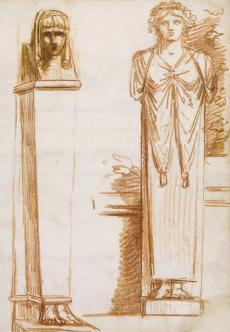


As M. V. Dobroklonsky wrote in 1964, ‘There must have been special reasons why such an original draughtsman as André Le Brun remained in almost complete oblivion until 1954, when Stanis?awa Sawicka published an article. The explanation for this neglect lies largely in the fact that André Le Brun, who was born in 1737, left his native country very early and worked all the rest of his life in Italy, Poland, and Russia.’ A subsidiary reason – and as a consequence of the foregoing one – is that most of his graphic works are to be found in Polish and Russian collections, so that, even if published, they will often have been in articles in those two Slavonic languages, to which many may not have access or cannot read, though they may at least be able to profit from the illustrations to them.
As Dobroklonsky further wrote, ‘Drawing occupied a major place in Le Brun’s artistic activity. The artist’s style is original and highly individual; drawings by his hand, in whatever collection they are found, reveal a style so easily identifiable that attribution involves no problems.’ This is, however, truer of his – more frequently encountered – drawings in ink and wash (six of the seven plates illustrating Dobroklonsky’s article are in those media) than it is of those in red chalk, highly distinctive though many of those are too (but his remark that, ‘Le Brun’s drawings in red chalk are more commonplace in execution, and considerably less interesting.’ is only true of some of them); hence, the present drawing having for some time had the recto regarded as by Hubert Robert (1733-1808), but the verso as by Le Brun. The fullest account of Le Brun as a draughtsman is Sawicka’s later article; in this too, however, only one of the five drawings that is illustrated is in red chalk, rather than ink and wash.
Since then, Professor Katarzyna Mikocka-Rachubova has published a two-volume monograph on the artist. Not having had access to this, I am profoundly indebted to her for her kindness in confirming (on the basis of electronic images) the attribution to Le Brun of both sides of the present drawing and for suggesting that they should be dated to his second sojourn in Rome (between 1773 and 1779) and, more specifically, to 1773 or 1774, when Le Brun was sculpting a standing statue of Minerva for King Stanislaus Augustus, which is now in the Royal Castle in Warsaw. There may even have been a direct connection with that, since, though the poses of both the drawings of Minerva differ from that of the sculpture, the fall of the drapery of the one on the right is very similar (and neither appears to have been copied from any antique statue in Rome). The two herms likewise seem to have been of Le Brun’s own invention (the presence of feet, but absence of genitalia, would seem to preclude their having been copies of antique examples too).
He was a French sculptor and draughtsman, active in Poland and Russia. He studied with Jean-Baptiste Pigalle and in Rome. After 1768 he became court sculptor to Stanislaus Augustus, King of Poland. In 1808 he was appointed first professor of sculpture at the University of Vilnius.